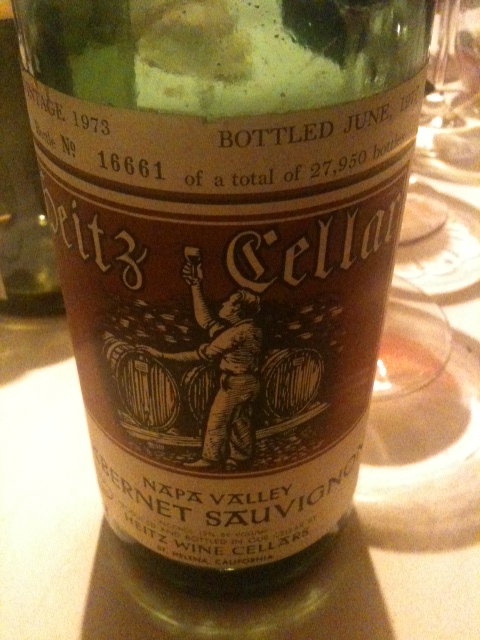(MEXICO CITY) I arrived at the airport here yesterday for a promotion of One Wine One World, and I received an email on my iPhone from an American friend in Bordeaux who is a wine merchant. Jeff Davies, the owner of Signature Selections, is well-known in wine circles, and I enjoy hanging out with him wherever our paths may cross in the world. There’s always a good bottle to share. I am sure you know friends like that.
Anyway, I was impressed with his email following my Napa Valley Cabernet Sauvignon report. So I thought I would share it with you after I asked him if it would be okay. Check it out. (The yellow markings are his for emphasis.)
It seems many others share similar sentiments regarding what I wrote in the introduction to the tasting report. How about you?
On Feb 17, 2011, at 9:28, Jeffrey Davies wrote:
Enjoyed your article/tasting on the 2006/2007 Napa Valley Cabernets. Think you pretty well summed it up with your remarks below.

I am not sure it is true, but my impression from a number of Napa winemakers is that many wineries are pulling the reins back a bit on the full-throttle in-your-face high-alcohol fruit-bomb wines for more balanced and refined ones. This, in my opinion, would be a great thing. I recently drank a bottle of 1968 Beaulieu Vineyard Private Reserve Georges De Latour in Hong Kong and the wine was gorgeous, with such complexity and finesse. It went wonderfully with our Italian meal at Otto e Mezzo restaurant. I miss those great Cabs from the 1950s, 1960s and 1970s. They were all about balance.
“Why doesn’t California make wines like this anymore?” asked my friend, who is an important wine merchant and collector in Hong Kong. “They go so well with food. So many California wines you taste now are overdone and you can’t drink them with food.”
May be he needs to try more California wine to understand that the finesse and balance is certainly there? But the perception of many in the global market is very much like his. California reds are too alcoholic and don’t go with food.
Another obvious problem with California — particularly Napa Valley Cab — is pricing. I was shocked to hear a number of wine producers say to me that they thought their wines were a “good value” because they were $125 a bottle. Maybe I have been gone from the States for too long, but $125 is not a good value. Napa Valley Cabernet Sauvignon on the whole is too expensive. Wine producers have to be more reasonable.
I did a wine tasting of California wine in Hong Kong for Watson’s Wine Cellars, and the overwhelming comment from the 50 or so wine lovers in attendance was that California wine was too expensive.
I did notice, that much like myself, you seemed to have a consistent preference for the hillside wines (Colgin, Sloan, Chappellet, Shafer “Hillside Select,” etc.) from the eastern side of the Valley with one possible exception (Ovid). And from the western side as well (Diamond Creek, Harlan, etc.). The one vineyard source, however, that seems to belie the superiority of the hillside vineyards, would seem to be Andy Beckstoffer’s To Kalon vineyard.
And yet, most of those great Cabernets from the 1950s and 1960s that you enjoyed with your father — as did I, on occasion, with my parents — came from valley floor fruit (BV Private Reserve, Charles Krug “Vintage Select,” Robert Mondavi “Reserve,” and some of the Inglenook “Cask” bottlings). The only memorable exceptions were Mayacamas and some of Heitz’s bottlings, but those didn’t really gain much attention until the early 1970s.
Chappellet has certainly made a significant comeback! I believe that Donn Chappellet’s Pritchard Hill vineyards were among the first vineyards high up in the hills on the eastern side of the Valley. Lee Stewart’s Souverain, the original one, may have been up in that vicinity, too.
I still have a few bottles of things from the early 1970s. Next time you’re here!

The best bottles I have had are the 1994 Groth (beautiful wine!) and a few examples of Insignia. The '99 Insignia beeing the latest that I have had and it is outstanding.
Having said this, I almost exclusively stick to and look for wines in the $50.00 range such as the basics Heitz, Cuvaison and the occasional Mondavi Napa, which are not always oustanding but quite enjoyable.
Availability here in QC (where is the Chapellet!) is also an issue.
At the end of the day though, there is clearly a market for these overpriced Cali Cabs and I suspect the majorty of which are consumed by Americans who are willing to pay the price...Not much different than Bordeaux I guess. If the market can bear the price than they will continue to charge the price.
Marc